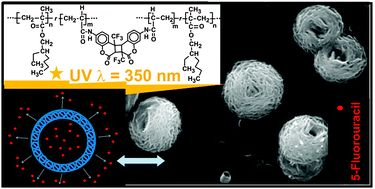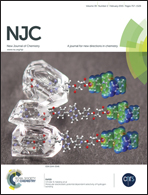Nanocapsules for 5-fluorouracil delivery decorated with a poly(2-ethylhexyl methacrylate-co-7-(4-trifluoromethyl)coumarin acrylamide) cross-linked wall
Abstract
The first synthesis of polymer vesicles with reverse cross-linked walls from poly[2-ethylhexylmethacrylate-co-(7-(4-trifluoromethyl)coumarin acrylamide)] P(EHMA/FMCA) is reported. The synthesis, carried out under UV light (λ = 350 nm), was achieved via radical photopolymerization of hydrophobic compounds saturating the bilayer of 1,2-dimyristoyl-sn-glycero-3-phosphocholine (DMPC) liposome template. The polymerization reaction with coumarin moieties has a pivotal role, because the polymer chains become cross-linked as a result of the dimerization of the coumarin side chains of the formed polymers and, in this way, spherical capsules are obtained. Moreover, thanks to the incorporation of coumarin moieties, as an additional bonus, a nanometer-thick porous, fluorescent wall was formed, avoiding the use of additional cross-linking reagents, which might deactivate the encapsulated payloads. We present a new paradigm of release drug delivery systems combining a long shelf-life with the ability for rapid release using external factors such as light. To demonstrate this concept, target compounds such as hydrophilic dyes (Lucifer yellow (LY), phenosafranin (PhS)) and the drug 5-fluorouracil (5-FU)) were incorporated inside the stable, hollow, polymeric nanocapsules. The goal of these applications depends on the versatile strategy that is used for the preparation of highly emissive nanometer-sized polymer capsules with surface functionalities and optical properties for diagnostic applications.


 Please wait while we load your content...
Please wait while we load your content...